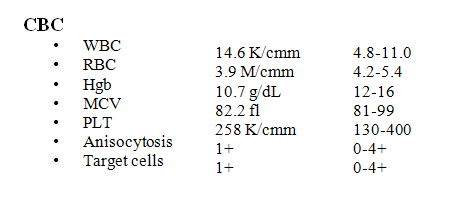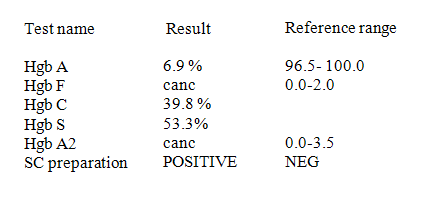
![]() Contributed by Oana Mihaela Radu, MD and Dmitriy Gutkin, MD, PhD
Contributed by Oana Mihaela Radu, MD and Dmitriy Gutkin, MD, PhD
PATIENT HISTORY
The patient was a 31 year-old female that moved to Pittsburgh from California one year back. She has a history of episodic pain involving arms, legs and abdomen (pain usually starts at night or in the morning when she wakes up). In July of 2008 she developed pain crisis at child delivery. After her move to Pittsburgh, in May 2009, she was admitted to a hospital with nausea and vomiting. A CT scan was consistent with pneumonia. She had a favourable course after being treated wih Azithromycin. Three months later, in August 2009 she presented to the same hospital complaining of fever and productive cough (green sputum). Once again, her diagnosis was pneumonia and she improved after iv Moxifloxacin. Her clinical scenario prompted an extensive work-up, including a CBC and peripheral blood smear.
PATIENT WORK-UP

Peripheral blood smear

Figure 1. Peripheral blood reveals a large number of target cells and folded forms
Hemoglobin electrophoresis

Figure 2: Acid hemoglobin electrophoresis.

Figure 3: Alkaline hemoglobin electrophoresis
Hemoglobin concentrations

Hemoglobin electrophoresis interpretation
"Pattern consistent with HB SC DISEASE"
ASSAY PRINCIPLE AND INTERPRETATION
Method 1: hemoglobin electrophoresis
Substitution mutations that result in the replacement of one amino acid by another with a different electrical charge can lead to slight changes in the overall charges of the protein. These allelic variants (in DNA) give rise to protein variants called allozymes that differ slightly in electrical charge. Protein electrophoresis is used to detect allozyme variation.

Tissue extracts are introduced into a solid support medium (a gel) in the sample wells at the Origin on the right-hand side of the gel. An electrical field is applied. Many proteins have a net negative charge and will migrate from the Origin at the cathode ("black," "negative") end towards the anode ("red", "positive") end of the field. Positions of the protein products are detected either directly by staining, or by coupled enzymatic reactions.

Method 2: high pressure liquid chromatography
Also called high performance liquid chromatography. Used to separate, identify and quantify compounds based on their idiosyncratic polarities and interactions with the column's stationary phase.
HPLC utilizes:
Analyte retention time varies depending on the strength of its interactions with the stationary phase, the ratio/composition of solvent(s) used, and the flow rate of the mobile phase. The increased density arises from smaller particle sizes. This allows for a better separation on columns of shorter length when compared to ordinary column chromatography.
